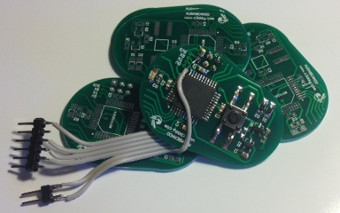 Home
Projects
Articles
Support
☰
Home
Projects
Articles
Support
☰


A flexible PCB has been used so that buttons and LEDs can be folded over the design. This version is encased in transparent thermoplastic to hold the shape in place.
15 September 2024

The device uses USB-C charging of a 4F supercapacitor to replace batteries. The firmware has been updated with a training mode.
7 September 2024

An artistic shape has been used influenced by the local indigenous culture. The PCB was manufactured by Oshpark using the After Dark option.
5 September 2023

The device now uses two WS2812C LEDs to indicate colour-coded scores ranging from red through green and blue to purple.
6 February 2023

The second run of manufactured devices have been delivered. They incorporate a PCB mounted coin cell holder to simplify the design and enclosure development.
3 November 2022

Our first manufactured devices have been delivered.
11 September 2021

We have started a production run of 30 units with our manufacturers in China. The cost per unit is quite high in small quantities but this will enable us to carry out further product development and market research.
12 August 2021

Our AuraBean website is up and running. It is planned that this will to be the front end for product sales and information.
31 March 2017

We have revised the design to incorporate lower cost parts including the use of the ATtiny13A microcontroller.
28 July 2016

It fits the enclosure, but more detailed work is required.
11 June 2016

A more fitted enclosure has been designed and sent off to 3DPrint-AU for printing.
10 May 2016

This is an illustration of a simple enclosure suitable for 3D printing. The two halves fit together with holes aligned for the buttons and LEDs.
19 December 2015

Here's revision 2 with dual buttons and LEDs. This model gives better feedback and allows the device to record your score. Also included is a switching output that can drive a small vibration motor or buzzer.
26 August 2015

The scores at the moment appear to be no better than chance. However, getting 8 guesses correct in a row during a sample run of 24 attempts is interesting. In revision 2 we will try using two buttons to simplify automatic recording of the score.
22 August 2015

Field trials have begun to test if a probability of better than chance is possible when guessing if the device is turned on or off.
10 August 2015

The PCBs have arrived and we've put one together. All those extra wires just facilitate USB 5V supply to the 3.3V power system so that we can prototype code without needing batteries.
31 July 2015

The first prototype circuit boards have been sent to China for manufacture and should be ready to be assembled and tested in a couple of weeks.
24 July 2015

The soft power latch works on paper. We've drawn the circuit using the Circuit Scribe conductive ink pen on paper and soldered some components in place. A momentary press of the ON button turns the circuit on, whilst the KILL button turns the circuit off.
23 July 2015

We found a soft power latch circuit on EEVblog that is exactly what we are looking for. One momentary press of the power button turns the circuit on, and another button turns it off. The circuit draws no power when off, and allows the facility for a microcontroller to monitor the on button and turn the circuit off itself.
17 July 2015